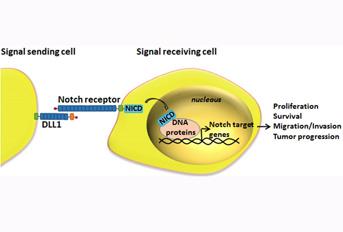Associação Portuguesa de Investigação em Cancro
The Notch ligand DLL1 exerts carcinogenic features in human breast cancer cells from different subtypes
The Notch ligand DLL1 exerts carcinogenic features in human breast cancer cells from different subtypes

Downregulation of DLL1 protein (a ligand of the Notch signaling pathway) decreases the carcinogenic properties of cancer cells from various human breast cancer subtypes in different manners. This study, developed by scientists from iBET, contributes to the knowledge of the mechanisms involved in the pathobiology of breast cancer and to the development of new therapies to target this disease.
Authors and Affiliations:
Joana Sales-Dias1,2, Gabriela Silva1, Márcia Lamy1, Andreia Ferreira1, Ana Barbas1,3
1- iBET, Instituto de Biologia Experimental e Tecnológica, Apartado 12, 2780-901 Oeiras, Portugal
2- ITQB, Instituto de Tecnologia Química e Biológica António Xavier, Universidade Nova de Lisboa, Av. Da República, 2780-157 Oeiras, Portugal
3- Bayer Portugal, Carnaxide, Portugal
Abstract:
Breast cancer (BC) is the most common type of cancer in women and has a high rate of relapse and death. Notch signalling is crucial for normal breast development and homeostasis. Dysregulation of Notch receptors and ligands has been detected in different BC subtypes and shown to be implicated in tumour development, progression, drug resistance, and recurrence. However, the effects of Notch ligands in various types of BC remain poorly understood. In this study, we investigated the effects of the Notch ligand DLL1 in three different human BC cell lines: luminal A MCF-7, luminal B BT474, and triple-negative MDA-MB-231. We showed that DLL1 expression is higher in MCF-7 and BT474 than in MDA-MB-231 cells, and that these cells respond differently to DLL1 downregulation. Functional assays in MCF-7 cells demonstrated that siRNA-mediated DLL1 downregulation reduced colony formation efficiency, migration, proliferation, caused cell cycle arrest at the G1 phase, and induced apoptosis. Gene expression studies revealed that these effects in MCF-7 cells were associated with increased expression of p21 and decreased expression of genes that promote cell cycle progression (CDK2, SKP2), and survival (BCL2, BIRC5), providing a possible model whereby DLL1 downregulation exerts some of its effects. Moreover, our results demonstrate that treatment with recombinant DLL1 increased MCF-7 cell proliferation and migration, confirming that DLL1 contributes to these processes in these luminal A BC cells. DLL1 downregulation reduced the colony formation efficiency of BT474 cells and decreased the migration and invasion abilities of MDA-MB-231 cells but showed no effects in the proliferation and survival of these cells.
Conclusions: These findings provide further evidence that DLL1 exerts carcinogenic effects in BC cells. The dissimilar effects of DLL1 downregulation observed amongst MCF-7, BT474, and MDA-MB-231 cells is likely due to their distinctive genetic and biologic characteristics, suggesting that DLL1 contributes to BC through various mechanisms.
Journal: PLOSONE
Link: https://journals.plos.org/plosone/article?id=10.1371/journal.pone.0217002






